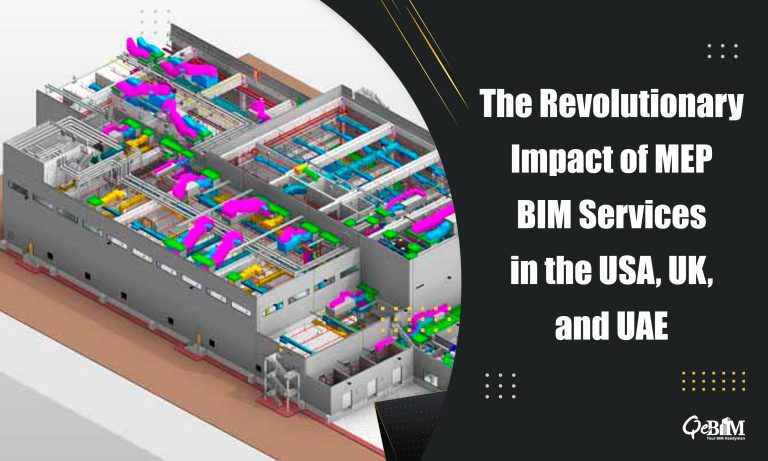The Revolutionary Impact of MEP BIM Services in the USA, UK, and UAE

Introduction:
In recent years, the field of engineering has witnessed a transformative wave with the advent of cutting-edge technologies. Among these, BIM has emerged as a game-changer, especially in the Mechanical, Electrical, and Plumbing (MEP) sector. This article delves into the profound impact of MEP BIM Services on the engineering landscape, examining the specific transformations observed in the United States, the United Kingdom, and the United Arab Emirates.
Understanding MEP BIM Services:
MEP BIM services involve the creation and management of digital representations of the physical and functional characteristics of a building’s MEP systems. These encompass mechanical, electrical, plumbing, and fire protection components. The utilization of BIM technology in the MEP sector enables seamless collaboration, data accuracy, and efficient project management throughout the building lifecycle.
The USA: Embracing Technological Advancements
In the United States, the engineering sector has experienced a significant shift towards BIM adoption. According to a report by Dodge Data & Analytics, around 71% of the surveyed architects, engineers, and contractors in the USA were already using BIM in 2021. This indicates a growing recognition of the benefits of BIM services in enhancing project efficiency and reducing costs.
Key Transformations in the USA:
1) Improved Collaboration and Coordination:
-
- BIM fosters collaboration among different stakeholders by providing a centralized platform for project data. This has led to enhanced coordination between MEP professionals, architects, and contractors.
- Statistics show that 68% of BIM users in the USA reported improved communication and collaboration among project teams (Source: Dodge Data & Analytics).
2) Cost Savings and Efficiency:
-
- BIM Coordination Services facilitates the identification of clashes and conflicts in MEP systems during the design phase, reducing the likelihood of rework during construction.
- A study by the National Institute of Building Sciences (NIBS) indicates that projects utilizing BIM experience a 20% reduction in project delivery time and a 10% reduction in overall project costs.
3) Energy Efficiency and Sustainability:
-
- MEP BIM services enable engineers to simulate and analyse the energy performance of buildings, leading to the design of more energy-efficient and sustainable structures.
- The USA is witnessing a growing emphasis on green building practices, and BIM plays a pivotal role in achieving sustainability goals.
The UK: Pioneering BIM Implementation
The United Kingdom has been at the forefront of BIM implementation, driven by government mandates and a strong commitment to digital transformation in the construction industry. The UK government’s BIM Level 2 mandate, implemented in 2016, has been a catalyst for the widespread adoption of BIM across the construction sector.
Key Transformations in the UK:
1) Government Mandates and Standardization:
-
- The UK’s BIM Level 2 mandate requires the use of BIM on all publicly funded projects. This has led to a standardized approach to BIM implementation and increased collaboration among project stakeholders.
- According to the UK BIM Alliance, 70% of respondents in their survey reported a positive impact on project outcomes due to the implementation of BIM.
2) Enhanced Project Lifecycle Management:
-
- BIM supports the entire project lifecycle, from design and construction to operation and maintenance. This comprehensive approach ensures that data continuity is maintained, leading to better-informed decision-making.
- A survey by the Royal Institution of Chartered Surveyors (RICS) revealed that 62% of respondents believe that BIM has positively impacted asset management and operation.
3) Skills Development and Training:
-
- The UK has invested significantly in upskilling its workforce to meet the demands of BIM adoption. Training programs and certifications have become integral to ensuring that professionals are proficient in BIM technologies.
- BIM adoption in the UK has been accompanied by a growing emphasis on education and training, ensuring a skilled workforce capable of harnessing the full potential of BIM.
The UAE: Embracing Innovation in Construction
The United Arab Emirates has rapidly embraced innovation in the construction sector, with a focus on incorporating advanced technologies to enhance project efficiency and sustainability. MEP BIM services have played a crucial role in this transformation.
Key Transformations in the UAE:
1) Technological Integration in Mega Projects:
-
- The UAE is home to numerous mega projects, and BIM has become a cornerstone in the planning and execution of these ambitious endeavors.
- Statistics from the Dubai Municipality indicate a significant increase in BIM adoption in the region, with 80% of projects implementing BIM in 2021.
2) Smart Cities and Sustainable Development:
-
- The UAE’s commitment to smart cities and sustainable development aligns with the capabilities of MEP BIM services in optimizing energy usage and resource efficiency.
- The incorporation of BIM in the UAE’s construction projects aligns with the nation’s vision for a sustainable and technologically advanced future.
3) Streamlining Regulatory Compliance:
-
- BIM facilitates compliance with regulatory requirements, ensuring that construction projects adhere to local building codes and standards.
- In the UAE, where regulatory compliance is paramount, BIM adoption has streamlined the process of meeting and exceeding construction and safety standards.
Conclusion:
MEP BIM Services are undeniably transforming the engineering sector in the USA, UK, and UAE. From improved collaboration and cost savings to enhanced sustainability and regulatory compliance, the impact of BIM is far-reaching. As these countries continue to embrace digital transformation, the role of MEP BIM services will only become more integral, ushering in a new era of efficiency, accuracy, and innovation in the field of engineering.